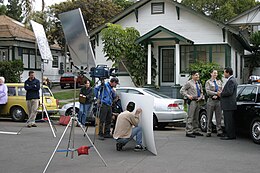Video production
This article may need to be rewritten to comply with Wikipedia's quality standards. (August 2020) |
Video production is the process of producing video content. It is the equivalent of filmmaking, but with video recorded either as analog signals on videotape, digitally in video tape or as computer files stored on optical discs, hard drives, SSDs, magnetic tape or memory cards instead of film stock.
Television broadcast
[edit]
Two styles of producing video are ENG (Electronic news-gathering) and EFP (Electronic field production).[1]
Video production for distance education
[edit]Video production for distance education is the process of capturing, editing, and presenting educational material specifically for use in on-line education. Teachers integrate best practice teaching techniques to create scripts, organize content, capture video footage, edit footage using computer based video editing software to deliver final educational material over the Internet. It differs from other types of video production in at least three ways:[2]
- It augments traditional teaching tools used in on-line educational programs.
- It may incorporate motion video with sound, computer animations, stills, and other digital media.
- Capture of content may include use of cell phone integrated cameras and extend to commercial high-definition Broadcast quality cameras.
Webcasting is also being used in education for distance learning projects; one innovative use was the DiveLive programs.[3]
Internet video production
[edit]Increasing internet speeds, the transition to digital from physical formats such as tape to file-based media and the availability of cloud-based video services has increased use of the internet to provision services previously delivered on-premise in the context of commercial content creation for example video editing. In some cases the lower costs of equivalent services in the cloud has driven adoption and in others the greater scope for collaboration and time savings.[4][5]
Individual Internet marketing videos are primarily produced in-house and by small media agencies, while a large volume of videos are produced by big media companies, crowdsourced production marketplaces, or in scalable video production platforms.[6]
See also
[edit]References
[edit]- ^ Medoff, Norman; Fink, Edward J. (2012-09-10). Portable Video: ENG & EFP. CRC Press. ISBN 978-1-136-04770-1.
- ^ Moore, M. G., & Kearsley, M. G. (2012). 'Distance education: A systems view of on line learning'. (3rd ed.). Belmont, CA: Wadsworth/Cengage Learning.
- ^ "Live from Morehead City, it's Queen Anne's Revenge". ncdcr.gov.
- ^ "Will facilities ever go completely cloud-based". 26 February 2018.
- ^ Price, Allison (15 June 2015). "Shifting Gears: How cloud is revolutionizing TV post-production".
- ^ "The Advantages of Individual Marketing". Retrieved 31 May 2019.
External links
[edit] Media related to Video productions at Wikimedia Commons
Media related to Video productions at Wikimedia Commons
